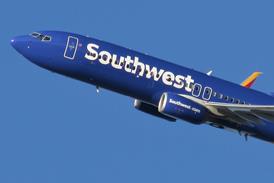Tim Furniss
China is ready to become the world's third nation to put a man into space.
The second launch of a Long March 2F booster with the Chinese Shen Zhou spacecraft from Jiuquan in the Gobi Desert is expected this year to test the craft before a manned flight.
The Shen Zhou was first tested unmanned in orbit in November 1999 and returned safely to the Earth. The craft was equipped with a "dummy human being" and was provided with a pressurised atmosphere in a "normal living and working environment," say Chinese space officials, who also reveal that each manned spacecraft will cost about 1 billion yuan ($120 million) to build.
The spacecraft entered a 197km by 323km orbit with an inclination of 42deg and landed 21h later in inner Monglia in northern China. The capsule's parachute was released at an altitude of 30km and a retro rocket fired at 1.5m above the ground to cushion the impact.
The officials also say that although the Chinese astronaut training centre south of Beijing has not yet been completed, parts of it have already been used to train national astronauts.
The centre includes a full set of ground simulation test facilities, including isolation chambers, low pressure sealed cabins and temperature-changing cabins, test cabins for life support systems and the largest home-built centrifuge in Asia, officials say.
The Shen Zhou's 2F booster is an uprated version of the Long March 2E satellite launch vehicle and the spacecraft is based on the design of the Rusian Soyuz TM craft, which made regular trips to and from the Mir space station and which will be used to support the International Space Station (ISS). Shen Zhou will carry two and eventually four, Chinese astronauts.
The 2F booster is equipped with a Russian Soyuz-like payload shroud on its top, together with a Soyuz-type launch escape tower. China has been working closely with Russia in the design of the spacecraft and two astronauts have undergone a Soyuz training programme.
The programme's close link to the Russian-manned space programme has been per-petuated with the arrival at the Yuri Gagarin Cosmonaut Training Centre in Zvezdny Gorodok, "Star City", near Moscow in 1996 of a group of Chinese "trainers" and two identified "taikonauts", Wu Tse and Li Tsinlung. Their one-year training was paid for on a commercial basis. Taikonaut is taken from "taikong", the Chinese word for space or cosmos.
The main difference in the processing of the Long March F booster is that it is conducted in the vertical position at Jiuquan and, unlike other Long March boosters, the vehicle is rolled to the launch pad vertically on the transporter.
The first roll-out of the rocket occurred in May 1998 and was spotted by US spy satellites which also saw the vehicle rolled back soon after. This was followed by several rollouts to the pad and back as Chinese technicians tried to solve technical problems with the vehicle before the hoped-for maiden flight in September-October 1998. The launch was subsequently delayed a year.
Like the Russian Soyuz, the Shen Zhou craft has a service module, a flight cabin and an orbital module. Two pairs of solar panels are deployed from the service and orbital modules, to provide electrical power. The Soyuz has only one pair of panels.
The orbital module has a docking unit to enable it to join up with another craft to form a mini-space station or enable it perhaps to dock with the ISS one day.
The manned craft is part of the Project 921, the name given to the overall Chinese manned space programme which includes not only the manned craft but also the launch vehicle, training and communications network.
China's space aspirations do not stop at launching Wu and Li. Among the follow-on plans for the Chinese space programme are the development of a small Space Shuttle spaceplane and the liquid oxygen-kerosene powered Long March 5, incorporating a new fleet of high performance upper stages powered by cryogenic liquid oxygen-liquid hydrogen propellant to enhance orbital performance. As proposed, the largest of these vehicles would be able to place 70t into low Earth orbit - possibly a national space station.
Source: Flight Daily News























